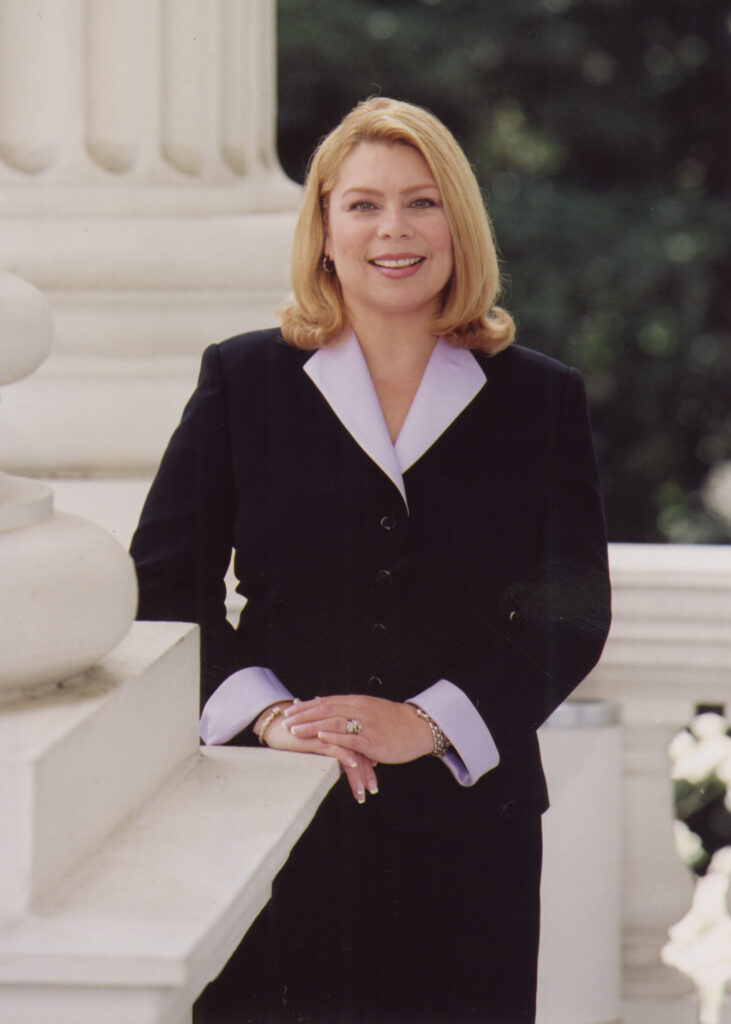
Jenny Oropeza was a barrier-breaking elected official whose career built on the activism of many Chicanos. This curated collection gives us a glimpse into the too short life of a dynamic public servant who spent more than 30 years fighting on the local and state level.
Jennifer “Jenny” Ann Oropeza was born in Montebello, California on September 27, 1957, to Victor and Sharon Oropeza. She was the eldest of three children. Poverty, alcoholism, and divorce brought periods of hardship to the family. Nonetheless, Jenny always attributed her drive to fight for what she wanted in life to the lessons her parents and previous generations taught her. From an early age she strove to succeed in school and found a love for the performing arts. While attending Alhambra High School she received a Junior Achievement award and was acclaimed “Actress of the Year.”
In 1975, with help from her best friend Sharon Weissman, she applied and was accepted into California State University, Long Beach (CSULB) as a Business Administration major. The 1970s marked a turning point in the university’s student demographics, in large part due to the Educational Opportunity Program (EOP) which opened admission to more first-generation college students from historically marginalized and impoverished communities. Increased diversity at the university encouraged student advocacy for racial and gender equity in school policies, programs, and administration. It is within this context that Jenny began her political career. A fight to keep tuition costs from rising propelled Jenny into the sphere of student government. In 1979 she became the first Latina elected Associated Students (A.S.) President and the first student elected twice to the position. She also became the first Latina to serve as a student member of the CSU Board of Trustees in 1981, appointed by Governor Jerry Brown.
While at CSULB, Jenny met and married fellow student Tom Mullins in 1977. She settled into a life in Long Beach, but never abandoned her political ambitions. Fresh out of the university she worked on Los Angeles Mayor Tom Bradley’s gubernatorial campaign and then took a job as a field representative for Assemblyman Charles Calderon of Montebello. She was also a member of the Long Beach Chicano Political Caucus (LBCPC)—a political advocacy group started by community members in 1976 that sought to increase Latinx electoral participation. Loss of federal funding for affirmative action and anti-poverty programs in the Reagan Era concerned Jenny. In response, she and the caucus found it necessary to politically organize and elect politicians who would support issues that mattered to the city’s rapidly growing Latinx population.
Before the mid-1980s, the Long Beach City Council was largely white, male, and conservative. No Latinx person had yet held a position within the council even though the demographic represented nearly half of the city’s population. The 1st Council District (Downtown) where Jenny lived was more than 56% Latinx. Jenny ran for the council seat in 1986 but lost. Two years earlier, Jenny led the fight alongside the LBCPC to change Long Beach Unified School District Board of Education elections from city-wide to by-district voting. This change helped increase diversity of political representation in local government, making way for Jenny to become the first Latinx elected to the school board, a position she held from 1988 to 1994.
Wanting to make a bigger impact, her mind was set on winning a city council seat. In 1994 she broke yet another barrier by becoming the first Latinx elected to Long Beach City Council. She served the 1st District from 1994 to 2000 and promised to be a councilmember for all. Crime reduction, downtown revitalization, and expansion of green spaces in the park-poor district were among her top priorities. In 1996, the City Selection Committee elected Jenny to the Los Angeles County Metropolitan Transportation Authority’s Board where she sought to improve the efficiency and accessibility of public transit.
By the new millennium, Jenny was primed to take her political career to the California State Legislature. She was elected assembly member to the 55th District in 2000, a position she held until she was elected state senator to the 28th District in 2006. Her personal health battles and life experiences made her a champion for legislation on improved healthcare, affordable education, clean air and environmental regulations, public transportation, food insecurity, equity, and more. Her dedication and dynamic life as a community activist and elected official left a memorable mark upon the history of this city and the state of California.
In 1975, with help from her best friend Sharon Weissman, she applied and was accepted into California State University, Long Beach (CSULB) as a Business Administration major. The 1970s marked a turning point in the university’s student demographics, in large part due to the Educational Opportunity Program (EOP) which opened admission to more first-generation college students from historically marginalized and impoverished communities. Increased diversity at the university encouraged student advocacy for racial and gender equity in school policies, programs, and administration. It is within this context that Jenny began her political career. A fight to keep tuition costs from rising propelled Jenny into the sphere of student government. In 1979 she became the first Latina elected Associated Students (A.S.) President and the first student elected twice to the position. She also became the first Latina to serve as a student member of the CSU Board of Trustees in 1981, appointed by Governor Jerry Brown.
While at CSULB, Jenny met and married fellow student Tom Mullins in 1977. She settled into a life in Long Beach, but never abandoned her political ambitions. Fresh out of the university she worked on Los Angeles Mayor Tom Bradley’s gubernatorial campaign and then took a job as a field representative for Assemblyman Charles Calderon of Montebello. She was also a member of the Long Beach Chicano Political Caucus (LBCPC)—a political advocacy group started by community members in 1976 that sought to increase Latinx electoral participation. Loss of federal funding for affirmative action and anti-poverty programs in the Reagan Era concerned Jenny. In response, she and the caucus found it necessary to politically organize and elect politicians who would support issues that mattered to the city’s rapidly growing Latinx population.
Before the mid-1980s, the Long Beach City Council was largely white, male, and conservative. No Latinx person had yet held a position within the council even though the demographic represented nearly half of the city’s population. The 1st Council District (Downtown) where Jenny lived was more than 56% Latinx. Jenny ran for the council seat in 1986 but lost. Two years earlier, Jenny led the fight alongside the LBCPC to change Long Beach Unified School District Board of Education elections from city-wide to by-district voting. This change helped increase diversity of political representation in local government, making way for Jenny to become the first Latinx elected to the school board, a position she held from 1988 to 1994.
Wanting to make a bigger impact, her mind was set on winning a city council seat. In 1994 she broke yet another barrier by becoming the first Latinx elected to Long Beach City Council. She served the 1st District from 1994 to 2000 and promised to be a councilmember for all. Crime reduction, downtown revitalization, and expansion of green spaces in the park-poor district were among her top priorities. In 1996, the City Selection Committee elected Jenny to the Los Angeles County Metropolitan Transportation Authority’s Board where she sought to improve the efficiency and accessibility of public transit.
By the new millennium, Jenny was primed to take her political career to the California State Legislature. She was elected assembly member to the 55th District in 2000, a position she held until she was elected state senator to the 28th District in 2006. Her personal health battles and life experiences made her a champion for legislation on improved healthcare, affordable education, clean air and environmental regulations, public transportation, food insecurity, equity, and more. Her dedication and dynamic life as a community activist and elected official left a memorable mark upon the history of this city and the state of California.
Preserving a Political History
After nearly a decade of cancer-related struggles, the Honorable State Senator Jenny Oropeza died on Wednesday, October 20, 2010 at Long Beach Memorial Medical Center. She was 53 years old and running for her second senate term. She passed two weeks shy of election day when she posthumously defended her seat. Family, friends, politicians across parties, and constituents all mourned the sudden loss of the barrier-breaking and outspoken politician from Long Beach. She left behind her husband Tom Mullins, mother Sharon Oropeza, sister Lynne Oropeza, brother John Oropeza, niece and goddaughter Alisha Espinoza, her nephew Joe Oropeza. and many other loved ones.
For thirteen years personal materials related to her political career sat in cardboard boxes, unorganized and exposed to the elements of an old unattached garage in her Westside home. Tom’s passing in 2023 inspired Oropeza family friend and Long Beach Harbor Commissioner Sharon Weissman to entrust Jenny’s personal political collection to the Historical Society of Long Beach (HSLB). With funding from Commissioner Weissman and The Port of Long Beach, HSLB was able to organize, rehouse, catalog, and freely present this collection to the public. Commissioner Weissman’s role as Jenny’s former chief of staff and close friend further provided the HSLB with invaluable insight into the materials and their relation to the senator’s life.
The Jenny Oropeza Collection joins the HSLB’s extensive archive which traces the growth of Long Beach from a small seaside resort to the large and diverse city it is today. The archive contains over one million historical items including photographs, documents, maps, ephemera, newspapers, and artifacts. These materials have been donated to the HSLB by individuals looking to preserve the history of this city, their families, neighborhoods, organizations, and businesses. The Jenny Oropeza Collection will now help inform visitors and researchers of Long Beach’s changing politics in the last half of the twentieth century, and the role Jenny played in this change.
Email archives@hslb.org if you are interested in donating a historical collection or item. Visit hslb.org to learn more about how you can financially support our preservation efforts.
For thirteen years personal materials related to her political career sat in cardboard boxes, unorganized and exposed to the elements of an old unattached garage in her Westside home. Tom’s passing in 2023 inspired Oropeza family friend and Long Beach Harbor Commissioner Sharon Weissman to entrust Jenny’s personal political collection to the Historical Society of Long Beach (HSLB). With funding from Commissioner Weissman and The Port of Long Beach, HSLB was able to organize, rehouse, catalog, and freely present this collection to the public. Commissioner Weissman’s role as Jenny’s former chief of staff and close friend further provided the HSLB with invaluable insight into the materials and their relation to the senator’s life.
The Jenny Oropeza Collection joins the HSLB’s extensive archive which traces the growth of Long Beach from a small seaside resort to the large and diverse city it is today. The archive contains over one million historical items including photographs, documents, maps, ephemera, newspapers, and artifacts. These materials have been donated to the HSLB by individuals looking to preserve the history of this city, their families, neighborhoods, organizations, and businesses. The Jenny Oropeza Collection will now help inform visitors and researchers of Long Beach’s changing politics in the last half of the twentieth century, and the role Jenny played in this change.
Email archives@hslb.org if you are interested in donating a historical collection or item. Visit hslb.org to learn more about how you can financially support our preservation efforts.
Educational Installation Hours
On Display March 13, 2025 – August 1, 2025
Tuesday 1:00 – 5:00 pm
Wednesday 1:00 – 5:00 pm
Thursday 1:00 – 7:00 pm
Friday 1:00 – 5:00 pm
Saturday 11:00 am – 5:00 pm
Admission is Free!


